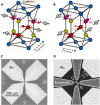Terahertz electrical writing speed in an antiferromagnetic memory
- PMID: 29740601
- PMCID: PMC5938222
- DOI: 10.1126/sciadv.aar3566
Terahertz electrical writing speed in an antiferromagnetic memory
Abstract
The speed of writing of state-of-the-art ferromagnetic memories is physically limited by an intrinsic gigahertz threshold. Recently, realization of memory devices based on antiferromagnets, in which spin directions periodically alternate from one atomic lattice site to the next has moved research in an alternative direction. We experimentally demonstrate at room temperature that the speed of reversible electrical writing in a memory device can be scaled up to terahertz using an antiferromagnet. A current-induced spin-torque mechanism is responsible for the switching in our memory devices throughout the 12-order-of-magnitude range of writing speeds from hertz to terahertz. Our work opens the path toward the development of memory-logic technology reaching the elusive terahertz band.
Figures






References
-
- Chappert C., Fert A., Van Dau F. N., The emergence of spin electronics in data storage. Nat. Mater. 6, 813–823 (2007). - PubMed
-
- Brataas A., Kent A. D., Ohno H., Current-induced torques in magnetic materials. Nat. Mater. 11, 372–381 (2012). - PubMed
-
- Kent A. D., Worledge D. C., A new spin on magnetic memories. Nat. Nanotechnol. 10, 187–191 (2015). - PubMed
-
- Waldrop M. M., The chips are down for Moore’s law. Nature 530, 144–147 (2016). - PubMed
-
- Ralph D. C., Stiles M. D., Spin transfer torques. J. Magn. Magn. Mater. 320, 1190–1216 (2008).
Publication types
LinkOut - more resources
Full Text Sources
Other Literature Sources

